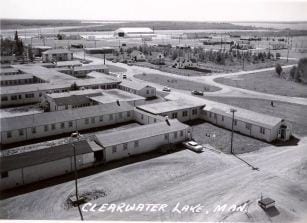A Manitoba researcher is hoping Inuit will contribute to a multi-year research project about historical experiences of tuberculosis.

Inuit were sent to sanatoriums in Manitoba, such as Clearwater Lake Indian Hospital pictured here, for tuberculosis treatment. Researcher Mary Jane McCallum, who is working on a multi-year project, is hoping Inuit will contribute.
Indigenous Histories of Tuberculosis in Manitoba is University of Winnipeg associate professor Mary Jane McCallum's project. She wants to write a book to inform Canadians about a little-known aspect of the country's history.
"There is a mainstream narrative about tuberculosis history in Manitoba that is very celebratory of the key doctors, physicians, maybe health researchers as well, in the treatment and then control of tuberculosis. It's always this kind of story about the struggle against the disease – between these white male professionals and the disease. They win the war, right?" said McCallum.
"Our experience of interviewing Indigenous people who worked in those institutions and who were patients there is a very different kind of story – or stories, I should say."
She also draws a parallel between policies developed during the years of segregated sanitariums and policies that continue to exist today.
"This era of health care in Manitoba is very influential for what happens afterwards. There are remnants of it, I think, today. I'm trying to understand the rationale behind segregated hospitals, why these systems were created, how they were created, and why they've been around for so long," she said. "There are still many of these ideas that were practiced at this time, the '30s, '40s and '50s, that are still around, I think."
Though McCallum's research is focused on the Manitoba sanitariums, Inuit were also taken south for treatment in Alberta and Ontario.
McCallum says the institutions in Clearwater Lake, Brandon and Dynevor were created specifically to treat Indigenous people. Clearwater Lake Indian Hospital, for example, was a repurposed United States Army field hospital built in 1943 and run by the Sanatorium Board of Manitoba on behalf of the federal government.
So far, McCallum and Scott de Groot, project coordinator since 2015, have interviewed 25 First Nations and Metis patients, as well as health care providers. But there's a big hole in the research: the Inuit perspective.
"It's a real gap. What we've managed to uncover is really the point of view of staff, and the San Board officials. So that's really unsatisfactory," said McCallum.
"The very first reference I saw was from around the 1950s of two Inuit children who were sent to Dynevor sanitarium, just north of Selkirk."
The researcher has also accessed a collection of letters written by Inuit patients in TB sanitariums and other institutions in the south at Library and Archives Canada.
"These letters are the only first-hand history of those institutions that we've got. Everything else is from the perspective of staff," said McCallum.
"They are an excellent window into what life would have been like in those institutions for Inuit."
Former staff interviewed by McCallum have, in some cases, given her photos.
"They gave us photographs or let us see the photographs they've taken. We just don't know what to do. I think we'll have to create some kind of archive, but we don't know the people who are in them, unless they were the person we interviewed," she said.
"In the Dynevor photos, there were Inuit. There are Inuit in the Clearwater Lake photos. The people that gave them to us didn't know which community they came from."
McCallum makes the point that the photographs she has in hand are not subject to privacy laws, which means she can show them to potential relatives or other community members who might recognize people who were treated at Manitoba sanitariums.
"Once we donate them to an archive, that's when they become closed," she said.
"If there were people interested in looking at those photos, and if they're interested in talking to us, that would be great."
McCallum and de Groot maintain a website at indigenoustbhistories.wordpress.com and McCallum can be reached through the University of Winnipeg.